The Vedas › Roman Mythology » Ancient origins
Articles and Definitions › Contents
- The Vedas › Ancient History
- Roman Mythology › Antique Origins
Ancient civilizations › Historical and archaeological sites
The Vedas › Ancient History
Definition and Origins
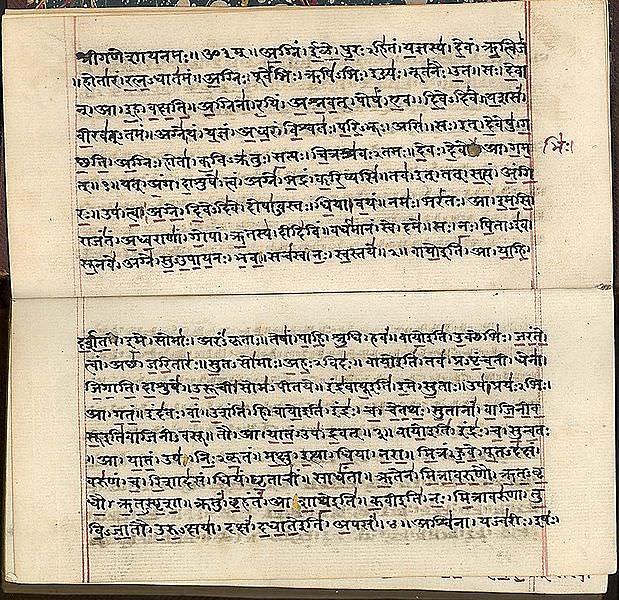
The Vedas are a collection of hymns and other ancient religious texts written in India between about 1500 and 1000 BCE. It includes elements such as liturgical material as well as mythological accounts, poems, prayers, and formulas considered to be sacred by the Vedic religion.
ORIGIN & AUTHORSHIP OF THE VEDAS
The origin of the Vedas can be traced back as far as 1500 BCE, when a large group of nomads called the Aryans, coming from central Asia, crossed the Hindu Kush Mountains, migrating into the Indian subcontinent. This was a large migration and used to be seen as an invasion. This invasion hypothesis, however, is not unanimously accepted by scholars today. All we know for certain, mainly through linguistic studies, is that the Aryan language gained ascendency over the local languages in the Indian sub-continent. The language of the Vedas is Sanskrit, an ancestor of most of the modern languages spoken today in South Asia.
VEDIC LITERATURE IS RELIGIOUS IN NATURE AND, AS SUCH, TENDS TO REFLECT THE WORLDVIEW & ATTITUDES OF THE BRAHMANS OR PRIESTLY CLASS OF ANCIENT INDIA.
We do not know much about the authors of these texts: In Vedic tradition the focus tends to be on the ideas rather than on the authors, which may allow one to look at the message without being influenced by the messenger. Vedic literature is religious in nature and as such tends to reflect the worldview, spiritual preoccupations, and social attitudes of the Brahmans or priestly class of ancient India. The Vedas were first composed sometime around 1500-1000 BCE in the north-western region of the Indian subcontinent - present-day Pakistan and northwest India - and they were transmitted orally over many generations before eventually being committed to writing. Like the Homeric epics, parts of the Vedas were composed in different periods.The oldest of these texts is the Rig- Veda, but it is not possible to establish precise dates for its composition. It is believed that the entire collection was completed by the end of the 2nd millennium BCE.
CONTENT & STRUCTURE
The basic Vedic texts are the Samhita “Collections” of the four Vedas:
- Rig-Veda “Knowledge of the Hymns of Praise”, for recitation.
- Sama-Veda “Knowledge of the Melodies”, for chanting.
- Yajur-Veda “Knowledge of the Sacrificial formulas”, for liturgy.
- Atharva-Veda “Knowledge of the Magic formulas”, named after a kind of group of priests.
In general, the Vedas have a strong priestly bias, as the priestly class had the monopoly in the edition and transmission of these texts.

Brahma
The Rig-Veda is the largest and most important text of the Vedic collection; it includes 1028 hymns and it is divided into ten books called mandalas. It is a difficult text, written in a very obscure style and filled with metaphors and allusions that are hard to understand for modern reader. The Sama-Veda has verses that are almost entirely from the Rig-Veda, but are arranged in a different way since they are meant to be chanted. The Yajur-Veda is divided into the White and Black Yajur-Veda and contains explanatory prose commentaries on how to perform religious rituals and sacrifices. The Atharva-Veda contains charms and magical incantations and has a more folkloristic style.
THE VEDAS PRESENT A MULTITUDE OF GODS, MOST OF THEM RELATED TO NATURAL FORCES SUCH AS STORMS, FIRE & WIND.
The Vedas present a multitude of gods, most of them related to natural forces such as storms, fire, and wind. As part of its mythology, Vedic texts contain multiple creation stories, most of them inconsistent with each other. Sometimes the Vedas refer to a particular god as the greatest god of all, and later another god will be regarded as the greatest god of all.
Some elements of the religion practised by the natives of India before Vedic times still persist in the Vedas. The Pre-Vedic religion, the oldest known religion of India, which was found in India before the Aryan migrations, was apparently an animistic and totemic worship of many spirits dwelling in stones, animals, trees, rivers, mountains, and stars. Some of these spirits were good, others were evil, and great magic skill was the only way to control them. Traces of this old religion are still present in the Vedas. In the Atharva-Veda, for example, there are spells to obtain children, to avoid abortion, to prolong life, to ward off evil, to woo sleep, and to harm or destroy enemies.
GODS & MYTHOLOGY
Despite the fact that the Rig-Veda deals with many gods, there are some who get a lot of attention. More than half the hymns invoke just three top-rated gods of the moment: Indra (250 hymns), Agni (200 hymns), and Soma (just over 100 hymns).
Indra was the head of the ancient Hindu pantheon. He was the Storm-god (sometimes he is referred to as the Sky-god and also as the god of war ). The Vedas describe Indra as the god “Who wields the thunderbolt”, and his most celebrated story was the killing of the demon-serpent Vritra. The legend says that Vritra kept all the waters trapped in his mountain lair, and Indra was the one who slew the demon in order to release the waters.
I have slain Vritra, O ye hast'ning Maruts;I have grown mighty through my own great vigour;I am the hurler of the bolt of ThunderFor man flow freely now the gleaming waters.(Mackenzie, Donald, Indian Myth.,54)
This story has a deep significance: The waters are vital for the health of any human community where agriculture is understood as the basis of wealth. By hoarding the waters, the serpent has upset the natural order, preventing the circulation of wealth and nourishment. Indra must thus do battle to restore the balance.
He, who slew the Dragon, freed the Seven Rivers, and drove thekine forth from the cave of Vala,Begat the fire between both stones, the spoiler in warrior's battle,He, O men, is Indra.(Rig-Veda 2.12.3)
Even the Heaven and the Earth bow down before him, before hisvery breath the mountains tremble.Known as the Soma-drinker, armed with thunder, the wielder of the bolt,He, O men, is Indra.(Rig-Veda 2.12.13)
Soma was the personification of the sacred soma plant, whose juice was holy and intoxicating to gods and men. Agni, the god of fire, is often referred to in Vedic literature as the most important god, and is considered to be the flame that lifts the sacrifice to heaven, a symbol of the fiery life and spirit of the world, the “vital spark”, the principle of life in animate and inanimate nature. Agni was seen as a sort of messenger between the realm of the living and the realm of the dead. Cremation was believed to prevent the spirit of the dead from remaining among the living, and for this reason, worshippers of Agni burned their dead, and Agni was responsible for transporting the soul of the dead.

Agni figure, Khajuraho
Another important deity is Varuna, who was initially associated with heaven. Varuna eventually developed into the most ethical and ideal deity of the Vedas, watching the world through his great eye, the sun, and was thought to know everything, to enforce justice and to preserve the world's smooth functioning. Varuna was also the executor and keeper of the eternal law known as Rita. This was at first the law that established and maintained the stars in their courses; gradually it became also the law of right, the cosmic and moral rhythm which every human must follow to avoid the celestial punishment.
The Vedas also have a hymn to Purusha, a primordial deity who is sacrificed by the other gods: Purusha's mind became the Moon, his eyes the Sun, his head the Sky, and his feet the Earth. In this same passage we have one of the first indications of a caste system with its four major divisions:
- The Brahmans, or priests, came from Purusha's mouth
- The Kshatriyas, or warrior rulers, from Purusha's arms
- The Vaishyas, or the commoners (land-owner, merchants, etc.), from Purusha's thighs.
- The Shudras, or labourers and servants, from Purusha's feet.
Myths are products of beliefs, and beliefs are products of experience. This story reflects the concerns and experiences of a community based on agricultural lifestyle, where water is seen as one of the most valuable assets. Myths with an agricultural significance are found in many other cultures and dragon-slaying myths are told all over the world, especially in many other Indo-European traditions.
LATER VEDIC PERIOD
During Vedic times, it was widely believed that rituals were critical to maintain the order of the cosmos and that sacred ceremonies helped the universe to keep working smoothly. In a sense, ceremonies were seen as part of a deal between humans and the gods: Humans performed sacrifices and rituals, and the gods would return their favour under the form of protection and prosperity.
A NEW SET OF TEXTS, KNOWN AS THE BRAHMANAS, WAS ATTACHED TO THE VEDIC COLLECTION AROUND THE 6TH CENTURY BCE.
Nature, however, remains indifferent to religious rituals, so when events went awry, society blamed the priests' incompetence.Priests were not willing to admit their helplessness in trying to master nature and would say that the gods ignored poor quality offers. The solution, the priests said, required more royal support. Brahman priests refused to have their privileges cut, so they developed a new literature which specified, sometimes in a very detailed way, how rituals had to be performed, the precise quantity and quality of material to be used, and the exact pronunciation of sacred formulas. This new set of texts, known as the Brahmanas, was attached to the Vedic collection around the 6th century BCE. The priests claimed that if sacrifices were performed exactly as they said, then the gods would be compelled to respond. When these new rituals also proved to be useless, many sectors of Indian society believed that this whole business of ritual and sacrifice had been taken too far.
During the later Vedic period (from c. 800 to c. 500 BCE), the priestly class was seriously questioned. The rituals, the sacrifices, the detailed rulebooks on ceremonies and sacrifices, all of these religious elements were being gradually rejected.Some of those who were against the traditional Vedic order decided to engage in the pursuit of spiritual progress, living as ascetic hermits, rejecting ordinary material concerns and giving up family life. Some of their speculations and philosophywere compiled into texts called The Upanishads. A number of practices were linked to this new spiritual approach: meditation, celibacy, and fasting, among others.
Around the 7th century BCE, India saw the growth of a culture of world-renunciation, which was a reaction against the Vedic tradition. This culture is the common origin of many Indian religions considered to be “heretical” by the Indian traditional priestly class. Charvaka, Jainism, and Buddhism, among other movements, originated around this time, encouraged by the gradual decay of the priestly orthodoxy. This would result in the end of the Vedic hegemony, shifting the focus of religious life from external rites and sacrifices to internal spiritual quests in the search for answers.
The authority of the Vedas eventually diminished to give way to a new religious synthesis in India that would dominate Indian society for the centuries to come.
Roman Mythology › Antique Origins
Definition and Origins
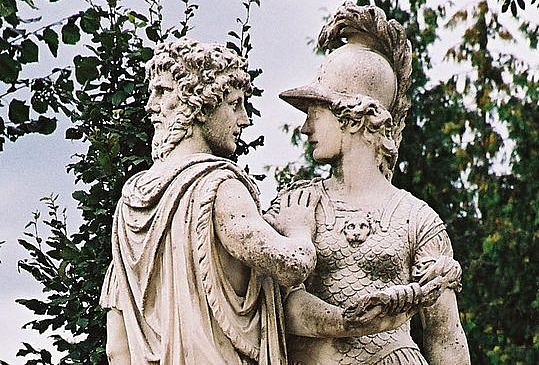
The ancient Romans had a rich mythology and, while much of it was derived from their neighbors and predecessors, the Greeks, it still defined the rich history of the Roman people as they eventually grew into an empire. Roman writers such as Ovid and Virgil documented and extended the mythological heritage of the ancient Mediterranean to gives us such long-lasting and iconic figures as Aeneas, Vesta, Janus, and the twin founders of Rome itself, Romulus and Remus.
THE PURPOSE OF MYTHS
Before one can delve into a study of mythology, one must understand the concept behind a myth. In his book The Greek and Roman Myths: A Guide to the Classical Stories, Philip Matyszak describes a myth simply as “the ancient's view of the world.” These myths -- although often appearing as simple stories filled with valiant heroes, maidens in distress, and a host of all-powerful gods -- are much more. The gods of the Greeks and Romans were anthropomorphic, exhibiting many human qualities such as love, hate, and jealousy, and because of this, the people of Rome and Greece were able to see themselves in these tales and understand their relationship to the rest of the world as well their connection to the gods. The lesson often to be learned was that one must meet one's destiny with strength, determination, and nobility. These myths enabled an individual to stand against the ills and hardships of an unforgiving universe. Matyszak states that, in spite of their constant disagreements and battles, the gods and humankind had to stand together against the “monsters and giants” of the world, or more simply, the “forces of disorder and wanton destruction.”
THE INFLUENCE OF GREEK MYTHS WAS SEEN EVERYWHERE IN ROME; IN THE ARCHITECTURE, SUBJECT MATTER, & ADORNMENTS OF SCULPTURES, TEMPLES, & MOSAICS.
Myths, whether Greek, Roman, any other culture's, at the end of the day were concerned with the relationship between the gods and humans, differing in this regard from fairytales and folktales. For all people, in many ways, myths made life bearable by providing security. They should not be easily dismissed as simple stories for, in both Greece and Rome, they dealt with important issues: the creation of the world, the nature of good and evil, and even the afterlife. And, for this reason, these tales have stood the test of time and become part of our present day culture. One only needs look at the names of our planets to see this: Mercury, Venus, Mars, Jupiter, Saturn, Neptune, Uranus and even poor little Pluto are all named for Roman gods.
GREEK ORIGINS
In Greece, myths were derived from a rich old oral tradition: Homer ’s Iliad and Odyssey and Hesiod 's Theogony. These were tales that had been passed down through the generations, first through the spoken word, and finally written down c. 8th century BCE. When Rome was founded in the 8th century BCE, many of the Greek city -states were already well-established.Greece even had founded colonies on the Italian peninsula and Sicily. Centuries later, after the four Macedonian Wars, these colonies would become a part of the early Roman Republic. This contact with Greece, and more specifically with Greek religion and mythology, had a lasting effect on Rome and its people. Rome was able to adopt much that defined Greece: art, philosophy, literature, and drama. Mythology, however, had to be adapted to reflect a Roman set of values.
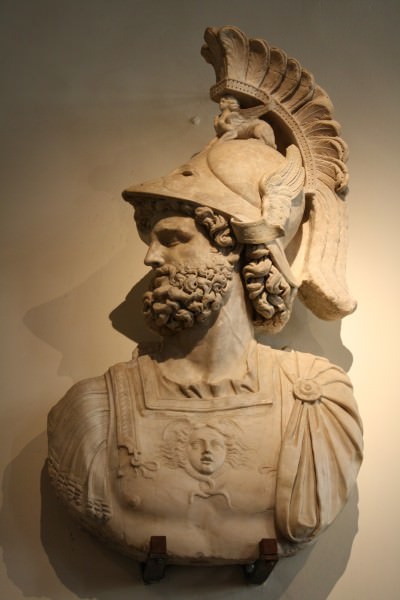
Mars Ultor
The influence of Greek myths was seen everywhere in Rome; in the architecture, subject matter, and adornments of sculptures, temples, and mosaics. This adoption of all that was Greek can be seen in the city's relationship to the Trojan War, a war that ultimately led to the most basic of Roman mythology : the birth of Romulus and Remus and the founding of a city.Whereas much of Greek mythology was transmitted through their poetry and drama, the Roman myths were written in prose, providing a sense of history and a foundation of all that was Roman: their rituals and institutions. In Roman mythology the difference between history and myth was almost indistinguishable: Rome was a city of destiny and the myths told that story.

The Lost Gods: The Romans (Planet Knowledge)
OVID
Many early Roman authors wrote on the myths of Rome. Ovid, before his exile by Emperor Augustus, wrote at a critical time in Roman history, politically and culturally. The emperor was hoping to reestablish a connection to the Republic's old religionand a reverence for the gods. Ovid penned several works centering on both Roman myth and religion -- Metamorphoses and Fasti are two of his best-known works. His stories, while mostly Greek, contained Roman names. In Fasti he portrayed the festivals of the first six months of the old Roman calendar, the legends of the gods, and the origin of many of their rituals. While early Roman mythology maintained a deep connection with the city and its rich history, it centered on one specific legend: the birth of its supposed founders: Romulus and Remus.
THE AENEID & AENEAS
While the true origin of Rome varies from source to source, historical as well as fictional, one of the earliest to relate the story (reminiscent of Homer's Odyssey ) was Virgil (Vergil) in his Aeneid, a tale that related the travels of its hero, the Trojan warrior Aeneas. The Aeneid has been said to exhibit the most complete expression of Roman mythology. In the story, our hero, with the assistance of his mother, the goddess Venus (his father was a mortal named Anchises), escaped Troy with his father and a number of his fellow soldiers before the city completely succumbed to the Greeks. This story and its connection to the Trojan War gave the Romans a link to the ancient Trojan culture. It should be noted that the story of the Trojan horse comes from Virgil, though mentioned in Homer's Odyssey. With Venus's assistance, the defeated Trojans leave the fallen city and set sail for Italy, where it has been foretold that Aeneas would found a city. They traveled first to Greece and then, as in Homer's tale, are blown off course. Jupiter's wife Juno constantly interferes with Aeneas throughout the story. They land at the African city of Carthage where our hero meets the beautiful Queen Dido, and of course, love follows, and he soon forgets his true purpose.
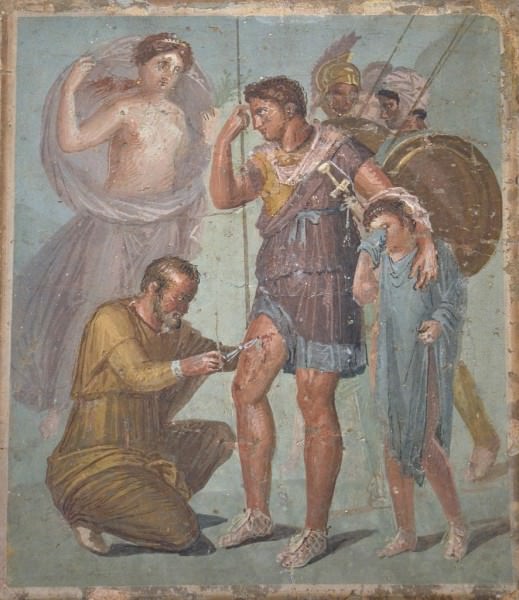
Fresco with Wounded Aeneas
Ultimately, the god Mercury intervenes and reminds Aeneas of his destiny, causing him and his men to reluctantly leave Africa and sail away; tragically, Queen Dido commits suicide over the loss of her beloved by throwing herself on a burning pyre. Upon landing at Cumae, Aeneas consults Sibyl, an oracle, who leads him into Hades where he not only encounters his fallen enemies and Queen Dido but also meets his recently deceased father who tells him of the great city his descendants would establish. Later, after reaching the mouth of the Tiber, the wayward Trojans enter into a war with King Turnus of the Rutuli (more of Juno's handiwork). Venus appeals to Vulcan (the Roman version of the Greek Hephaestus ) to make Aeneas new armor and weapons as he had done for Achilles. Turnus was finally defeated and killed in a duel. A peace is ultimately reached with Aeneas marrying the king's daughter; supposedly Jupiter had convinced Juno to end her war with Aeneas.
ROMULUS & REMUS
Aeneas's descendants became the founders of the city of his destiny: Rome. According to the legend, Romulus and Remus were the sons of the war god Mars and Rhea Silvia, daughter of the true king of Alba Longa, Numitor. In a coup, Amulius overthrew his brother and, to safeguard his claim to the throne, forced Rhea to join the Vestal Virgins. One day, Mars spied the young Rhea in the sacred woods and raped her. She bore two sons who, by order of King Amulius, were thrown in the Tiber. A recent flood caused them to drift ashore at Ficus Ruminalis. They were rescued by a she-wolf, the sacred animal of Mars (the wolf was supposedly aided by a woodpecker, another sacred animal of Mars). Later, the boys were adopted by a local herdsman named Faustulus and his wife Acca Larentia.
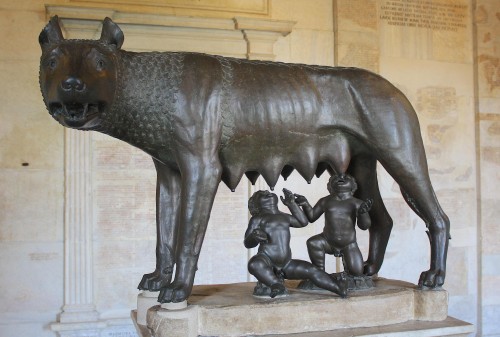
Romulus & Remus
Years pass and the two future founders of the city become leaders in their community, with Remus ultimately landing in the king's dungeon. Romulus rescued his brother, and with the assistance of Numitor, deposed Amulius. Of course, by this time the boys had learned of their true identity. Together they founded a city; however, in a dispute over the naming rights to the city, Remus is killed in a fit of jealousy, and the city becomes Rome. In one version of the dispute, the boys agreed to watch for omens in a flight of birds. Romulus won the naming rights and Remus was killed (Romulus was supposedly favored by the gods). Romulus would rule Rome for forty years.
ROMAN GODS & GODDESSES
Roman mythology, like that of the Greeks, contained a number of gods and goddesses, and because of the early influence of Greece on the Italian peninsula and the ever-present contact with Greek culture, the Romans adopted not only their stories but also many of their gods, renaming a number of them. One exception to this practice is the god Apollo, the only god whose name is common to both cultures. Originally, before their association with the Greeks, many of the Roman gods were more closely associated with cults rather than myths (as was the case with the Greek hero Heracles who became the Roman champion Hercules ). Much of this change came, however, when the Romans turned from farming to war.
JUPITER INFLUENCED EVERY ASPECT OF A ROMAN'S LIFE; HIS TEMPLE ON CAPITOLINE HILL WAS THE FINAL DESTINATION OF MANY VICTORIOUS MILITARY COMMANDERS.
Early in the development of Roman mythology, there was Saturn, equivalent to the Greek god Cronus. His temple at the foot of Capitoline Hill included the public treasury and decrees of the Roman Senate. The triad of early Roman cult deities were recreated as Jupiter, Juno, and Minerva ; the latter was the patron saint of craftsmen and goddess of school children (later associated with Athena ). Jupiter, the sky-god, became more akin to the Greek Zeus. Jupiter influenced every aspect of a Roman's life; his temple on Capitoline Hill was the final destination of many victorious military commanders who would leave a portion of their booty as an offering to Jupiter. His wife (and sister) Juno became reminiscent of Hera, presiding over every facet of Roman women's life, and in the case of Aeneas, vindictive against those she disliked.

Artemis / Diana
Similarly, the love-goddess Aphrodite became Venus, born from the foams of the sea, while the brothers of Zeus, Hades and Poseidon, became Pluto and Neptune respectively. The Greek Artemis was renamed Diana, the goddess of the hunt, while Ares, the war god, was now Mars who originally had been an agricultural god associated with spring, a time of regeneration (March is named for him). Roman commanders would always make a sacrifice to him before a battle. And lastly, one must not forget Hermes, the messenger, who turned into Mercury, a minor deity who had at one time been the god of trading and profit and, as mentioned, Hercules, the Roman version of Heracles.
As in Greece, Roman cities often adopted their own patron deity and built temples and performed rituals to honor that god.And, while the influence of the Greeks is vast, the Romans had a number of original gods of their own such as Janus, the two-faced god of doorways and gates (the city gates were open during the time of war and closed during the time of peace).Similar to the Etruscan god Culsans, Janus could see both the future and the past. Valued for his wisdom, he presided over the beginnings of all events. There was also Vesta, daughter of Saturn and the goddess of the hearth and family life, whose followers were called the Vestal Virgins. Though linked to the goddess Hestia of the Greeks, she took on her own distinct personality in Roman mythology. Numa, the second king of Rome, founded a cult dedicated to Vesta. Lastly, there was Faunus, the god of nature; he was worshipped as the protector of crops with a festival in December.
There were also a number of water gods, vitally important to the farmers, as every river and spring had its own deity (Juturna was the goddess of springs and water). Farmers had to appease these gods through a series of offerings. Tiberius was the god of the Tiber, and every May 27th straw dummies were thrown into the Tiber to pacify him. This is reminiscent of the ancient Roman belief in spirits --- supernatural forces that inhabited everything around them including people. Every May (9, 11, and 13) the festival of Lemuria was celebrated where the spirits of the dead were exorcized. Many Romans believed they were constantly watched over by the spirits of their ancestors.
While many people only think of the Greeks when the topic of mythology is considered, the Romans had a rich and vibrant mythology of their own. We all have heard, in some form, the story of the she-wolf and her saving the brothers Romulus and Remus and, in this same way, many other Roman myths have become a part of our culture in the present day. To the Greeks and the Romans, myths explained who they were as a people and gave them a sense of national pride, an understanding of valor and honor, and insight into their destiny.
LICENSE:
Article based on information obtained from these sources:with permission from the Website Ancient History Encyclopedia
Content is available under License Creative Commons: Attribution-NonCommercial-ShareAlike 3.0 Unported. CC-BY-NC-SA License